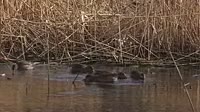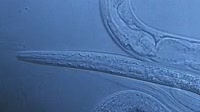Mud snail (Galba truncatula) with miracidia, free-living infective larvae of the liver fluke (Fasciola hepatica), a parasitic flatworm. Here the miracidia are swimming around the snail on the right, prior to infecting it via its soft tissues. Larvae will later emerge from the snail and form cysts on nearby vegetation. These may be ingested by a ruminant or by humans eating uncooked foods such as watercress. Flukes emerge from the cysts and migrate into the bile ducts where they pass eggs into the host's faeces which contaminate water. The eggs hatch to release miracidia, which infect snails, thus continuing the life cycle. Fascioliasis is a liver disease caused by liver fluke infection, with symptoms including digestive problems, fever, pain, anaemia and jaundice. Footage filmed at Ridgeway Research, Gloucestershire, United Kingdom.
Details
WebID:
C01841957
Clip Type:
RM
Super High Res Size:
1920X1080
Duration:
00:00:19.000
Format:
QuickTime
Bit Rate:
25 fps
Available:
download
Comp:
200X112 (0.00 M)
Model Release:
NO
Property Release
No













 Loading
Loading